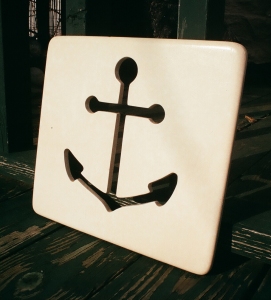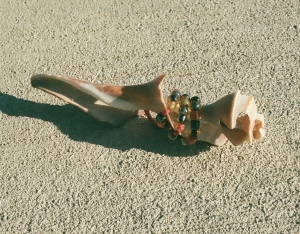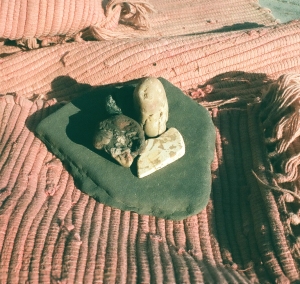Click on photos to enlarge them.
Decoratives – “Mae West” Anchor Cut-out Plaque (1998)
One of the items we salvaged from the sunken motor yacht once owned by Mae West was a cabinet “door” made from marine plywood in a style often used in ocean-going vessels. If you’ve ever been at sea on a boat smaller than a cruise liner, you know how much motion there is that is not “forward.” Boats roll, pitch, yaw, and generally act like never-ending roller coaster rides – it’s the stuff sea-sickness is made of.
So most yachts have many handholds in convenient spots for the crew to grab onto in the attempts to keep from been tossed around the cabin as the boat is tossed around by the waves. They also try to avoid having knobs and other devices that stick out and inevitably catch on one’s clothing and tear it. One typical solution is to have cabinets and lockers without handles or knobs. If the “door” is a simple panel with finger-sized holes in it, arranged more-or-less like those in a bowling ball, and is held in place by friction catches on the inside, they can be opened by inserting two or more fingers and pulling on it.
The “Mae West” used just such cabinet covers, but with the nice design touch of having the finger holes cut in the shape of an anchor. When one of them washed up on our beach, it immediately became a nice nautically flavored visual device. We detached the friction-catch bits from its back, and hung it on our bathroom wall.
(User warning! We actually feel that this style of cabinet cover is as dangerous as it is convenient. Once, on the way to Bermuda on a 44-foot sailing vessel equipped with these covers, this writer damn-near broke his finger when the boat lurched over a big wave while in the act of pulling one of them open!)
Decoratives – Boutonniere (2013)
As members of the Cooper-Hewitt National Design Museum, we were fortunate to be invited to a gala reception last November at the restaurant “Daniel” in New York City for the museum’s extremely popular “Design By Hand” public lecture series. The theme for the event was “Design Yourself.” I decided I had to create something that would promote our Dockwood Furniture concept of re-purposing “decayed” natural elements. The idea occurred to me of a boutonniere made from one of the Hearts-of-Whelk we’d been collecting from our beach, which, to me, look uncannily like half-opened calla lily blossoms. The shells of dead whelks are so fragile that their outer parts are broken away as they’re washed back and forth on the rocky shore, leaving the curving spirals of their inner parts, variously tinted in pale coral or purple hues. I took one of these, strung some colored glass beads from Sharynne’s bead collection on thin fuchsia-colored yarn, which I wrapped around the shell. Tying a button behind it made for a distinctive boutonniere for my navy double-breasted suit jacket. Most of the guests at the event sported custom-designed bits of jewelry or hats – “eye-candy” of the very best sort – but was mine the most original and distinctive? I think so.
– Dave Wilder
Rockpile 1 (2012)
Slate, stones, asphaltum, beach shard
Rocks
Rocks. Where would we be without them? After all, it’s “the third rock from the sun” we inhabit, is it not? As a child, I was fascinated by them. In California stream beds I found beautiful red-brown jasper pebbles worn smooth by the millennia. In the High Sierras you could make ancient granite crumble with your fingers – we called it “rotten granite.” On the north coast, there were beaches on which, after hours of searching, you might find a beautiful piece of polished “beach jade,” or jadeite.
Rocks are ancient and mystical. Ancient peoples sensed spirits or gods in them, and made them holy objects. Yet these days, in all their absurdity, one finds antique dealers offering “antique garden rocks” for sale! A good friend of ours commented, “You have to ask the dealer for their provenance! Are they 200 million years old? Or 500 million?”
We have collected rocks for as long as we can remember, mainly as souvenirs. They are reminders of many things: wonderful times on Cape Cod with our great group of friends; walks along quiet woodland creeks; the time we stayed on our boat off the mythical Gardiners Island and, in the middle of the night, dragged anchor because of a rock caught between its flukes – we definitely had to bring that one home!
A very good friend of ours has collected rocks forever – his wife says, “Our house is of full of rocks, and he won’t throw them out! Is this a sign of insanity?” No, it’s just rocks.
The beach at our current residence, being adjacent to land that’s been occupied and built on by colonial settlers since 1653, and earlier by Native Americans, with all kinds of development by subsequent occupants, is constantly churning up (with its strong tidal current and periodic storms) things like: bricks, sea glass, pottery chards, gobbets of asphaltum (congealed oil from ships, leaks, etc., combined with sand and small pebbles), and, of course rocks.
I couldn’t help myself: a broken piece of slate roof-tile, a bit of sea chard or sea glass, a blob of asphaltum, and a pretty little stone; they seemed to belong together, so I just stacked them up, and had a . . . rockpile. I’ve made four of them so far. Sharynne thinks they’re a bit silly, but I don’t care. I like ‘em
– Dave Wilder
Hurricane Sandy Bouquet (2013)
Sea glass (plate glass, vintage soda bottle), artificial flowers
The artificial flowers were washed ashore by Hurricane Sandy, one stem in our garden, and another in the back yard of our neighbor across the street. We soaked them in fresh water for a week or so, then gently scrubbed out the harbor mud to use them in a sad-but-hopeful bouquet.





Love that door! Love the backstory. Is the door solid wood or composite?